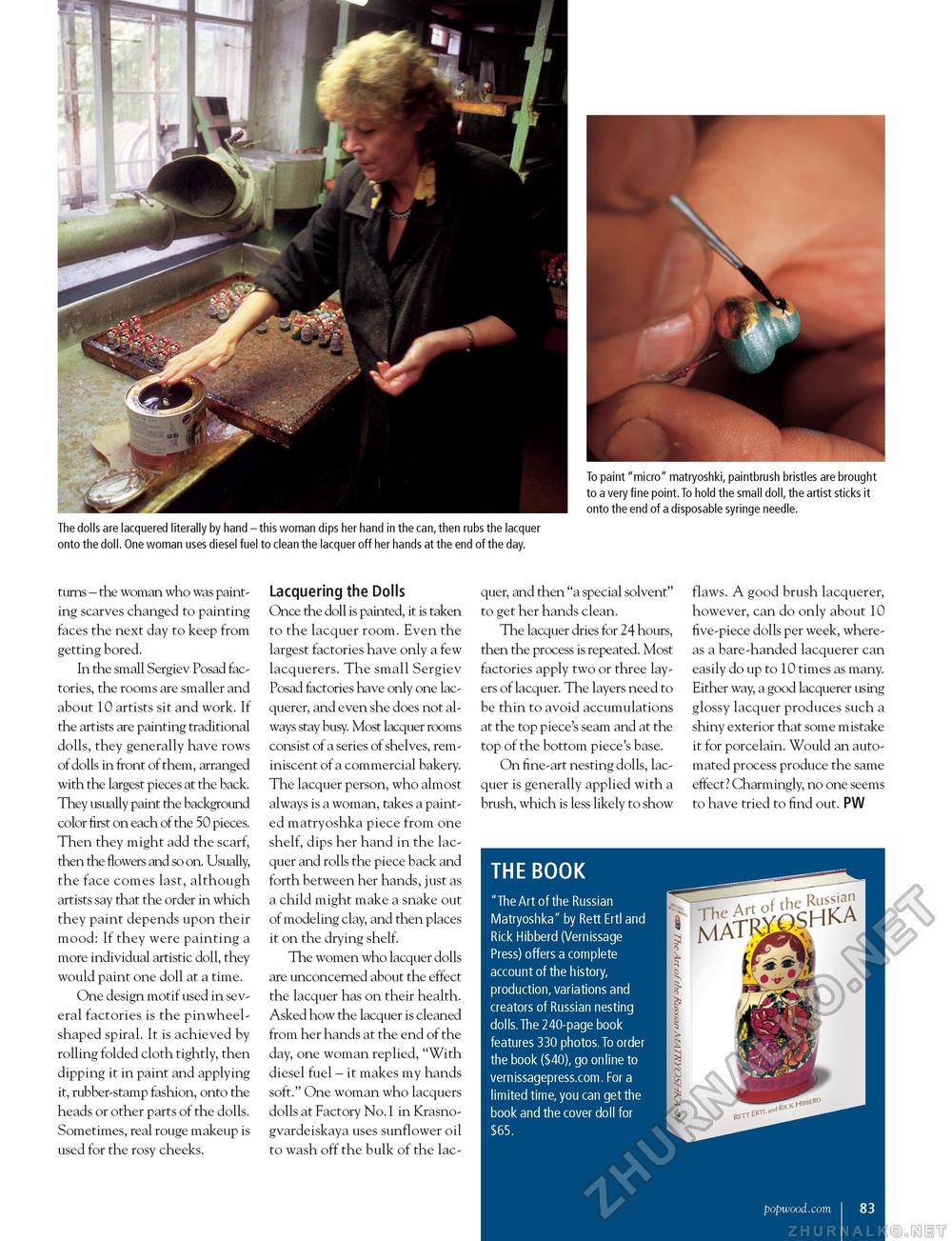Popular Woodworking 2003-10 № 136, страница 83
The dolls are lacquered literally by hand - this woman dips her hand in the can, then rubs the lacquer onto the doll. One woman uses diesel fuel to clean the lacquer off her hands at the end of the day. turns - the woman who was painting scarves changed to painting faces the next day to keep from getting bored. In the small Sergiev Posad factories, the rooms are smaller and about 10 artists sit and work. If the artists are painting traditional dolls, they generally have rows of dolls in front of them, arranged with the largest pieces at the back. They usually paint the background color first on each of the 50 pieces. Then they might add the scarf, then the flowers and so on. Usually, the face comes last, although artists say that the order in which they paint depends upon their mood: If they were painting a more individual artistic doll, they would paint one doll at a time. One design motif used in several factories is the pinwheel-shaped spiral. It is achieved by rolling folded cloth tightly, then dipping it in paint and applying it, rubber-stamp fashion, onto the heads or other parts of the dolls. Sometimes, real rouge makeup is used for the rosy cheeks. Lacquering the Dolls Once the doll is painted, it is taken to the lacquer room. Even the largest factories have only a few lacquerers. The small Sergiev Posad factories have only one lac-querer, and even she does not always stay busy. Most lacquer rooms consist of a series of shelves, reminiscent of a commercial bakery. The lacquer person, who almost always is a woman, takes a painted matryoshka piece from one shelf, dips her hand in the lacquer and rolls the piece back and forth between her hands, just as a child might make a snake out of modeling clay, and then places it on the drying shelf. The women who lacquer dolls are unconcerned about the effect the lacquer has on their health. Asked how the lacquer is cleaned from her hands at the end of the day, one woman replied, "With diesel fuel - it makes my hands soft." One woman who lacquers dolls at Factory No.1 in Krasno-gvardeiskaya uses sunflower oil to wash off the bulk of the lac quer, and then "a special solvent" to get her hands clean. The lacquer dries for 24 hours, then the process is repeated. Most factories apply two or three layers of lacquer. The layers need to be thin to avoid accumulations at the top piece's seam and at the top of the bottom piece's base. On fine-art nesting dolls, lacquer is generally applied with a brush, which is less likely to show THEBOOK "The Art of the Russian Matryoshka" by Rett Ertl and Rick Hibberd (Vernissage Press) offers a complete account of the history, production, variations and creators of Russian nesting dolls. The 240-page book features 330 photos.To order the book ($40), go online to vernissagepress.com. For a limited time, you can get the book and the cover doll for $65. flaws. A good brush lacquerer, however, can do only about 10 five-piece dolls per week, whereas a bare-handed lacquerer can easily do up to 10 times as many. Either way, a good lacquerer using glossy lacquer produces such a shiny exterior that some mistake it for porcelain. Would an automated process produce the same effect? Charmingly, no one seems to have tried to find out. PW popwood.com I 83 |








